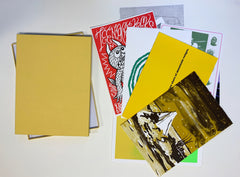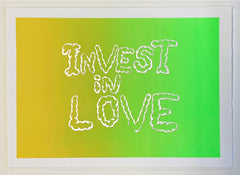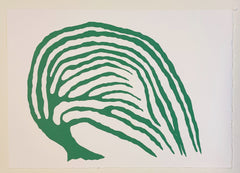About the edition
This print was created by Martin Boyce and produced in DCA Print Studio as part of 2020 Editions: a portfolio of prints created to mark an extraordinary, challenging year, and to support DCA's recovery from a crisis that has gripped the entire cultural sector.
As the UK-wide lockdown that began in March 2020 drew to a close, we invited a group of artists who had participated in our programme to submit work to be developed with our team in DCA Print Studio and included in a portfolio. Some had worked with us recently; others had taken part in projects soon after we opened in 1999, but all of them gave their time and work generously in support of DCA, and we are incredibly grateful to them.
The project came with some built-in specifications – shape, size, edition number – but the remarkable diversity of the finished works eloquently reflects the range of our programme, and the possibilities of working with our Print Studio.
Some time ago I came across an image of an old wall mounted phone. It was simultaneously familiar and distant, like an object in a fictional setting, one step removed from reality. There was something cinematic about this image which carried with it a silent sense of expectation and potential. I imagined being alone in an empty lobby and the phone ringing. What narrative would unfold if I lifted that receiver? From there I began to think of the telephone and its relationship to location and how a phone call would once have been a way to connect two fixed points in space and time. Two phones in two different rooms in two distant cities, a technological device as a portal, the direct intimacy of words spoken into a listening ear.
For my exhibition at Galerie Eva Presenhuber in Zurich I have made a series of painted panels with sculptural phones attached. The panels take the form of overpainted sections of wall complete with decorative moulding. The phones have been specially designed using shapes and angles from two graphic patterns that have appeared throughout my work over the years. Echoes of the Martel concrete trees can be found in the receiver while the main body of the phone uses a diagonal grid pattern from as far back as 1996. This grid was developed as a graphic motif for the idea of the city. The facade of a glass tower or the footprint of the modern city.
The screenprint for DCA shows one of the development drawings for the phone. Here you can see the grid present in the buttons but the additional diagonal lines drawn over the body show my thought process as I explore the possibility of shifting the shape of the phone to mirror the buttons. The finished phones, which were produced through a combination of CNC milling and silicon moulded resin casting, take on this rhomboid shape. For the print I overlaid the phone number of DCA, deliberately misaligning the numbers to produce a sense of memory or recall and the movement of fingers over the buttons. Martin Boyce
Other prints included in the 2020 Editions portfolio:
- Christine Borland
- Eve Fowler
- Ilana Halperin
- Hideyuki Katsumata
- Toby Paterson
- P. Staff
- Alberta Whittle
- Jane and Louise Wilson
- Clare Woods
Prints can be bought individually or as a portfolio of all 10 prints.
| Year | 2020 |
| Edition of | 30 |
| Media | Screenprint on Zerkall 225gsm paper |
| Dimensions | 29.7 x 42cm |
| Signature | Numbered on verso in pencil and accompanied by a publisher’s certificate of authenticity |
About Martin Boyce
Martin Boyce is an artist whose sculptural works recall and reference the materials, textures and forms of the built urban environment. Using the iconography of both the everyday and the history of modern architecture and design his sculptural installations form immersive environments and poetic landscapes.
Martin Boyce was born in Hamilton, Scotland in 1967. He studied at Glasgow School of Art 1986 -1990 (BFA) and 1995 -1997 (MFA) and California Institute of the Arts 1996 (MFA exchange program).
Boyce represented Scotland at the Venice Biennale 2009 with the exhibition No Reflections and was the winner of the 2011 Turner Prize.
In the last decade, his solo exhibitions include No Longer Fathom, Eva Presenhuber Gallery, Zurich (2020); The Light Pours Out, Esther Schipper Gallery, Berlin (2018); Hanging Gardens, A4 Museum in Chengdu, China (2018); Light Years, The Modern Institute, Glasgow (2017); Sleeping Chimneys. Dead Stars, Tanya Bonakdar Gallery, New York (2017); Spotlight - 'Do Words Have Voices', Tate Britain, London (2016); Spook School, CAPRI, Düsseldorf (2016); Martin Boyce: When Now is Night, RISD Museum, Providence (2015); Inside rooms drift in and out of sleep / While on the roof / An alphabet of aerials / Search for a language, Eva Presenhuber, Zurich (2015); Museum für Gegenwartskunst, Basel (2015); Stellar Remnants, Johnen Galerie, Berlin (2014); No Reflections, Venice Biennale, Venice (Scotland + Venice. Touring to DCA, Dundee) (2009);
Boyce unveiled new permanent commissions A Thousand Future Blossoms, 37 rue Sainte-Croix-de-la-Bretonnerie, Eataly Paris (2019) and Remembered Skies at the Tate Britain (2017) as part of the Clore Galleries and recently completed An Inn For Phantoms Of The Outside And In, Mount Stuart, Isle of Bute (2019). Boyce currently lives and works in Glasgow.Own Art
Spread the cost of buying artwork with Own Art and purchase Telephone Drawing by Martin Boyce in 10 monthly payments of £12 (representative 0% APR). Email editions@dca.org.uk for more information or to buy.Pick up in Store
If you would like to buy online and then collect your edition at DCA, please select the Pick up option at checkout. We will then be in touch to arrange a convenient collection time with you.


